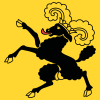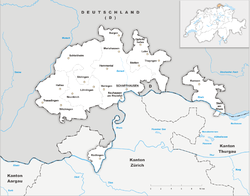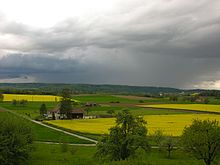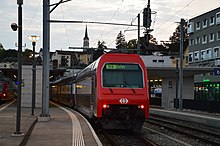Canton
| Canton of Schaffhausen Kanton Schaffhausen (German)Canton of Schaffhouse | |
|---|---|
| Canton | |
 Flag Flag Coat of arms[REDACTED] Logo Coat of arms[REDACTED] Logo | |
Location in Switzerland
Map of Schaffhausen
 | |
| Coordinates: 47°43′N 8°34′E / 47.717°N 8.567°E / 47.717; 8.567 | |
| Capital | Schaffhausen |
| Subdivisions | 26 municipalities |
| Government | |
| • Executive | Regierungsrat (5) |
| • Legislative | Kantonsrat (60) |
| Area | |
| • Total | 298.43 km (115.22 sq mi) |
| Population | |
| • Total | 83,107 |
| • Density | 280/km (720/sq mi) |
| GDP | |
| • Total | CHF 7.244 billion (2020) |
| • Per capita | CHF 87,569 (2020) |
| ISO 3166 code | CH-SH |
| Highest point | 912 m (2,992 ft): Hoher Randen |
| Lowest point | 344 m (1,129 ft): Rhine at Buchberg |
| Joined | 1501 |
| Languages | German |
| Website | www |
The canton of Schaffhausen, also canton of Schaffhouse (German: Kanton Schaffhausen; Romansh: Chantun Schaffusa; French: Canton de Schaffhouse; Italian: Canton Sciaffusa), is the northernmost canton of Switzerland. The principal city and capital of the canton is Schaffhausen. The canton's territory is divided into three non-contiguous segments, where German territory reaches the Rhine. The large central part, which includes the capital, in turn separates the German exclave of Büsingen am Hochrhein from the rest of Germany.
History
| This section needs additional citations for verification. Please help improve this article by adding citations to reliable sources in this section. Unsourced material may be challenged and removed. Find sources: "Canton of Schaffhausen" – news · newspapers · books · scholar · JSTOR (August 2022) (Learn how and when to remove this message) |
Schaffhausen was a city-state in the Middle Ages; it is documented that it struck its own coins starting in 1045. It was then documented as Villa Scafhusun. Around 1049, Count Eberhard von Nellenburg founded a Benedictine monastery which led to the development of a community. This community achieved independence in 1190. In 1330, the town lost not only all its lands but also its independence to the Habsburgs. In 1415, the Habsburg Duke Frederick IV of Austria sided with the Antipope John XXIII at the Council of Constance, and was banned by the Emperor Sigismund.
As a result of the ban and Frederick's need of money, Schaffhausen was able to buy its independence from the Habsburgs in 1418. The city allied with six of the Swiss confederates in 1454 and allied with a further two (Uri and Unterwalden) in 1479. Schaffhausen became a full member of the Old Swiss Confederation in 1501.
The first railroad came to Schaffhausen in 1857. In 1944, Schaffhausen suffered from a bombing raid by United States Army Air Forces planes that accidentally strayed from Germany into neutral Switzerland.
The cantonal constitution was written in 1876 and revised in 1895. The distinctive coat of arms bears the Schaffhauser Bock (Billy Goat of Schaffhausen).
Geography
| This section needs additional citations for verification. Please help improve this article by adding citations to reliable sources in this section. Unsourced material may be challenged and removed. Find sources: "Canton of Schaffhausen" – news · newspapers · books · scholar · JSTOR (August 2022) (Learn how and when to remove this message) |

Schaffhausen is the northernmost canton of Switzerland and lies almost entirely on the right bank of the Rhine, with only part of Stein am Rhein on the left bank. It lies west of Lake Constance and has an area of 298 km (115 sq mi). Much of the canton is productive agricultural land, with 134.4 km (51.9 sq mi) (about 45%) of the canton used for agriculture while an additional 128.7 km (49.7 sq mi) (about 43%) is wooded. Most of the rest of the canton, 31.8 km (12.3 sq mi) (about 10%), is developed, while only 3.8 km (1.5 sq mi) (1.3%) of the canton is unproductive (rivers, lakes or mountains).
The canton's territory is divided into three non-contiguous segments where German territory reaches the Rhine. The large central part, which includes the capital Schaffhausen, in turn partially (along with territory of two neighbouring cantons) separates the German exclave of Büsingen am Hochrhein from the rest of Germany. The small exclave of Rüdlingen-Buchberg lies to the southwest, and the third part contains Ramsen and Stein am Rhein to the east. With the exception of Vor der Brugg, part of Stein am Rhein, all three segments are separated from the rest of Switzerland by the Rhine.
The canton of Schaffhausen is bordered by the Swiss cantons of Zürich and Thurgau, as well as the German districts of Waldshut, Schwarzwald-Baar-Kreis and Konstanz, Baden-Württemberg.
Most of the canton lies on a plateau dominated by the Hoher Randen. The summit of this mountain is at 912 m (2,992 ft). The slopes of the mountain are gentle towards the south where it reaches the Rhine valley. Short and narrow valleys intersect these gentle slopes. The Klettgau is one such valley.
The Rhine Falls are the largest waterfalls in Europe and lie on the border of the cantons of Schaffhausen and Zürich.
Municipalities

There are 26 municipalities in the canton as of March 2017.
- Bargen
- Beggingen
- Beringen
- Buch
- Buchberg
- Büttenhardt
- Dörflingen
- Gächlingen
- Hallau
- Hemishofen
- Lohn
- Löhningen
- Merishausen
- Neuhausen am Rheinfall
- Neunkirch
- Oberhallau
- Ramsen
- Rüdlingen
- Schaffhausen
- Schleitheim
- Siblingen
- Stein am Rhein
- Stetten
- Thayngen
- Trasadingen
- Wilchingen
Merger
- In 1947, the municipality Buchthalen merged into Schaffhausen.
- In 1964, the municipality Herblingen merged into Schaffhausen.
- In 2004, the municipality Barzheim merged into Thayngen.
- In 2005, the municipality Osterfingen merged into Wilchingen.
- On 1 January 2009, the municipalities Altdorf, Bibern, Hofen, and Opfertshofen merged into Thayngen.
- In 2009, the municipality Hemmental merged into Schaffhausen.
- In 2013, the municipality Guntmadingen merged into Beringen.
Demographics
The population of the canton (as of 31 December 2020) is 83,107. As of 2007, the population included 16,323 foreigners, or about 21.9% of the total population. The German language and Protestant faith predominate. The majority of the population (as of 2000) is Protestant (50%) while a large minority is Roman Catholic (24%).
| Year | 1850 | 1880 | 1900 | 1950 | 1970 | 2000 |
|---|---|---|---|---|---|---|
| Population | 35 300 | 38 241 | 41 514 | 57 515 | 72 854 | 73 392 |
| Language | ||||||
| German | 38 117 | 40 290 | 55 257 | 61 518 | 64 323 | |
| Italian | 39 | 886 | 1 490 | 6 682 | 1 897 | |
| French | 149 | 264 | 529 | 553 | 370 | |
| Romansch | 4 | 16 | 101 | 139 | 80 | |
| Other | 39 | 58 | 138 | 3 962 | 6 722 | |
| Religion | ||||||
| Protestant | 33 880 | 33 897 | 34 046 | 44 408 | 46 772 | 37 025 |
| Catholic | 1 411 | 4 154 | 7 403 | 12 431 | 23 277 | 17 790 |
| Chr. Catholic | 275 | 192 | 83 | |||
| Other | 9 | 297 | 65 | 401 | 2 613 | 18 494 |
| Nationality | ||||||
| Swiss | 33 938 | 33 963 | 33 860 | 53 950 | 58 907 | 58 290 |
| Other | 1 362 | 4 278 | 7 654 | 3 565 | 13 947 | 15 102 |
Politics
Cantonal government
The legislature is the Cantonal Council (Kantonsrat) of Schaffhausen, which consists of 60 members elected proportionally every four years. Until 2008, it consisted of 80 members.
The executive branch is the Government Council (Regierungsrat), which consists of 5 members elected every four years.
Federal election results
| Percentage of the total vote per party in the canton in the Federal Elections 1971–2015 | ||||||||||||||
|---|---|---|---|---|---|---|---|---|---|---|---|---|---|---|
| Party | Ideology | 1971 | 1975 | 1979 | 1983 | 1987 | 1991 | 1995 | 1999 | 2003 | 2007 | 2011 | 2015 | |
| FDP.The Liberals | Classical liberalism | 33.1 | 40.1 | 32.3 | 26.2 | 34.3 | 28.6 | 31.9 | 40.4 | 29.1 | 26.7 | 12.3 | 12.9 | |
| CVP/PDC/PPD/PCD | Christian democracy | 8.0 | * | * | 6.3 | * | * | * | * | 2.7 | * | 5.2 | * | |
| SP/PS | Social democracy | 40.2 | 37.2 | 35.3 | 35.4 | 39.2 | 34.2 | 37.8 | 33.6 | 39.7 | 34.2 | 34.6 | 28.8 | |
| SVP/UDC | Swiss nationalism | * | * | 21.1 | 22.6 | 23.5 | 19.2 | 20.4 | 26.0 | 28.5 | 39.1 | 39.9 | 45.3 | |
| Ring of Independents | Social liberalism | 12.2 | 16.6 | * | 5.6 | * | * | * | * | * | * | * | * | |
| EVP/PEV | Christian democracy | * | * | 6.3 | * | * | * | * | * | * | * | * | * | |
| POCH | Progressivism | * | 6.1 | 4.1 | 2.7 | * | * | * | * | * | * | * | * | |
| GPS/PES | Green politics | * | * | * | * | * | * | * | * | * | * | * | 3.4 | |
| FGA | Feminist | * | * | * | * | * | 3.9 | * | * | * | * | * | * | |
| SD/DS | National conservatism | 6.4 | * | * | * | * | * | * | * | * | * | * | * | |
| EDU/UDF | Christian right | * | * | * | * | 3.0 | 2.7 | * | * | * | * | 3.8 | 5.1 | |
| FPS/PSL | Right-wing populism | * | * | * | * | * | 11.4 | 8.6 | * | * | * | * | * | |
| Other | * | * | 0.9 | 1.2 | * | * | 1.4 | * | * | * | 4.3 | 4.4 | ||
| Voter participation % | 78.7 | 74.1 | 75.1 | 73.7 | 69.6 | 69.0 | 64.4 | 61.9 | 63.2 | 65.3 | 60.8 | 62.6 | ||
- ^a FDP before 2009, FDP.The Liberals after 2009
- ^b "*" indicates that the party was not on the ballot in this canton.
Compulsory voting
Swiss citizens who live in the canton of Schaffhausen are required to vote in elections. Compulsory voting never existed on the national level in Switzerland. It was introduced in several cantons starting in the late 19th century. In 1974, it was abolished everywhere except in Schaffhausen. Citizens who do not vote have to pay a small fine.

Economy
Schaffhausen is a part of the Zürcher Wirtschaftsraum (Zürich economic region) and the canton's economy is well integrated with that of the wider region.
Well-regarded white Riesling wine is grown here as well as several other varieties. The main industries, however, are the production of machinery and metal goods. There is also watch making and jewellery. Minor industrial branches are textiles, leather goods, glass, cement, paper and chemicals. There is a brewery in the canton.
At Rheinau there is a hydro electrical power plant generating electricity for the canton and for export. Major electricity customers are the chemical industry in Rheinfelden and the aluminium plant at Neuhausen am Rheinfall. The city of Schaffhausen also uses much of the electricity produced at Rheinau.
Schaffhausen lies on the busy Milan-Zürich-Stuttgart rail line which is serviced by trains from both the Swiss Federal Railways and German Railways.
The largest companies are Tyco International, Tyco Electronics, SIG, Georg Fischer AG, International Watch Company and Cilag AG.
Transportation
Bus


The neighboring towns of Schaffhausen and Neuhausen am Rheinfall share a municipal bus network with frequent services (see: urban buses in Schaffhausen and Neuhausen).
There are several regional bus services that link towns and villages in the canton of Schaffhausen with each other or with towns in the adjacent canton of Zürich and nearby German territory, respectively. Bus services 21, 22, 23, 24, 25 and lines 630 and 634 (the latter two to villages in the northern part of canton of Zürich) all depart from the forecourt of Schaffhausen railway station in Schaffhausen. In addition, bus line 33 ( 7349 ) connects villages in the eastern part of the canton of Schaffhausen with Singen (Hohentwiel) (some courses continue to Konstanz) in Germany. Line 675 connects the villages of Rüdlingen and Buchberg in the southern part of the canton of Schaffhausen with Rafz and Henggart (both are in the canton of Zürich), respectively. Route 825 links Stein am Rhein in the eastern part of the canton of Schaffhausen with Frauenfeld, the capital of the canton of Thurgau. Lines 21, 22, 23, 24, 25, 27 and 28 are operated by Verkehrsbetriebe Schaffhausen (vbsh), while routes 630 , 634 , 675 , and 825 are operated by Postauto, and line 33 ( 7349 ) is run by Südbadenbus [de].
The regional bus lines are as follows (railway stations in bold letters):
Nighttime Bus
On weekends, there are night bus services operating on regional bus routes after midnight.
| Line | Route | Operator |
|---|---|---|
| N76 | Schaffhausen railway station – Schaffhausen, Falkeneck – Schaffhausen, Schlossweiher – Thayngen, Hüttenleben – Thayngen railway station – Schaffhausen, Falkeneck – Schaffhausen railway station | vbsh |
| N77 | Schaffhausen railway station – Neuhausen am Rheinfall – Beringen – Guntmadingen – Neunkirch – Oberhallau – Hallau – Wilchingen – Osterfingen – Trasadingen | vbsh |
Train




Several train stations in the canton of Schaffhausen provide S-Bahn-style services (lines designated with an "S" followed by the route number). Schaffhausen railway station is also served by InterCity (IC) and RegioExpress (RE) trains of Swiss Federal Railways (SBB CFF FFS) and Deutsche Bahn (DB), and Interregio-Express (IRE) and IC trains of DB. Two railway stations in the eastern part of the canton, Hemishofen and Ramsen on the Etzwilen–Singen railway, are closed to regular passenger service,
Train services are as follows (as of December 2023):
Schaffhausen station
- DB Fernverkehr IC 87 / SBB CFF FFS [REDACTED] : Zürich HB – Schaffhausen – Stuttgart Hbf (hourly service)
- RE48 (SBB CFF FFS): Schaffhausen – Bülach – Zürich Oerlikon – Zürich HB (hourly service)
- RE 3 (DB Regio Baden-Württemberg): Basel Bad Bf – Schaffhausen – Friedrichshafen-Hafen (hourly service)
- S1 (St. Gallen S-Bahn): Schaffhausen – Stein am Rhein – Kreuzlingen – Romanshorn – St. Gallen – Wil SG (half-hourly service)
- S9 (Zürich S-Bahn): Schaffhausen – Bülach – Zürich HB – Uster (hourly/half-hourly service)
- S12 (Zürich S-Bahn): Schaffhausen – Winterthur – Zürich HB – Brugg AG (hourly service)
- S24 (Zürich S-Bahn): Thayngen – Schaffhausen – Winterthur – Zürich Airport – Zürich HB – Zug (hourly service)
- S33 (Zürich S-Bahn): Schaffhausen – Winterthur (hourly service)
- S62 (Schaffhausen S-Bahn): Schaffhausen – Singen (Hohentwiel) (half-hourly service)
- S64 (Schaffhausen S-Bahn): Schaffhausen – Erzingen (Baden) (half-hourly service)
- S65 (Schaffhausen S-Bahn): Schaffhausen – Jestetten (hourly service)
Herblingen and Thayngen stations
- S24 (Zürich S-Bahn): Thayngen – Herblingen – Schaffhausen – Winterthur – Zürich Airport – Zürich HB – Zug (hourly service)
- S62 (Schaffhausen S-Bahn): Singen (Hohentwiel) – Thayngen – Herblingen – Schaffhausen – (half-hourly service)
Neuhausen station
- S9 (Zürich S-Bahn): Schaffhausen – Neuhausen – Bülach – Zürich HB – Uster (hourly/half-hourly service)
- S12 (Zürich S-Bahn): Schaffhausen – Neuhausen – Winterthur – Zürich HB – Brugg AG (hourly service)
- S24 (Zürich S-Bahn): Thayngen – Schaffhausen – Neuhausen – Winterthur – Zürich Airport – Zürich HB – Zug (hourly service)
- S33 (Zürich S-Bahn): Schaffhausen – Neuhausen – Winterthur (hourly service)
- S65 (Schaffhausen S-Bahn): Schaffhausen – Neuhausen – Jestetten (hourly service)
Neuhausen Rheinfall station
- S9 (Zürich S-Bahn): Schaffhausen – Neuhausen Rheinfall – Bülach – Zürich HB – Uster (hourly/half-hourly service)
- S65 (Schaffhausen S-Bahn): Schaffhausen – Neuhausen Rheinfall – Jestetten (half-hourly service)
Neuhausen Badischer Bahnhof, Beringerfeld, Beringen, Neunkirch, Wilchingen-Hallau and Trasadingen stations
- S64 (Schaffhausen S-Bahn): Schaffhausen – Neuhausen Badischer Bahnhof – Beringerfeld – Beringen Badischer Bahnhof – Neunkirch – Wilchingen-Hallau – Trasadingen – Erzingen (Baden) (half-hourly service)
Stein am Rhein station
- S1 (St. Gallen S-Bahn): Schaffhausen – Stein am Rhein – Kreuzlingen – Romanshorn – St. Gallen – Wil SG (half-hourly service)
- S29 (Zürich S-Bahn): Stein am Rhein – Winterthur (half-hourly service)
Boat
During warmer seasons (April to October), there are regular boat trips by the Schweizerische Schifffahrtsgesellschaft Untersee und Rhein (URh) on the River Rhine (High Rhine) between Schifflände in Schaffhausen and Kreuzlingen (Lake Constance) via Stein am Rhein.
Notes and references
- "Amtliches Gemeindeverzeichnis der Schweiz – MS-Excel Version | Publikation | Bundesamt für Statistik". Bfs.admin.ch. 23 March 2017. Retrieved 16 March 2021.
- Arealstatistik Land Cover - Kantone und Grossregionen nach 6 Hauptbereichen accessed 27 October 2017
- ^ "Ständige und nichtständige Wohnbevölkerung nach institutionellen Gliederungen, Geburtsort und Staatsangehörigkeit". bfs.admin.ch (in German). Swiss Federal Statistical Office - STAT-TAB. 31 December 2020. Retrieved 21 September 2021.
- Statistik, Bundesamt für (21 January 2021). "Bruttoinlandsprodukt (BIP) nach Grossregion und Kanton - 2008-2018 | Tabelle". Bundesamt für Statistik (in German). Retrieved 1 July 2023.
- ^ Coolidge, William Augustus Brevoort (1911). "Schaffhausen (town)" . In Chisholm, Hugh (ed.). Encyclopædia Britannica. Vol. 24 (11th ed.). Cambridge University Press. p. 312.
- Canton Schaffhausen website, Geography (in German). Retrieved 18 April 2009
- Federal Department of Statistics (2008). "Arealstatistik – Kantonsdaten nach 15 Nutzungsarten". Archived from the original (Microsoft Excel) on 25 July 2009. Retrieved 15 January 2009.(in German)
- "Répertoire officiel des communes de Suisse". Statistique Suisse. 23 March 2017. Retrieved 28 November 2017.
- Nomenklaturen – Amtliches Gemeindeverzeichnis der Schweiz (in German) accessed 28 November 2017
- Federal Department of Statistics (2008). "Ständige Wohnbevölkerung nach Staatsangehörigkeit, Geschlecht und Kantonen". Archived from the original (Microsoft Excel) on 15 December 2008. Retrieved 5 November 2008.
- Federal Department of Statistics (2004). "Wohnbevölkerung nach Religion". Archived from the original (Interactive Map) on 24 September 2016. Retrieved 15 January 2009.
- "Schaffhausen (Kanton)". hls-dhs-dss.ch.
- Nationalratswahlen: Stärke der Parteien nach Kantonen (Schweiz = 100%) (Report). Swiss Federal Statistical Office. 2015. Archived from the original on 2 August 2016. Retrieved 5 August 2016.
- Leybold-Johnson, Isobel (4 April 2014). "Democratic? The canton where voting is compulsory". swissinfo.ch. Retrieved 15 October 2020.
- Canton Schaffhausen website, Wine Production (in German). Retrieved 18 April 2009
- Canton Schaffhausen website- Economic Promotion Archived 17 July 2010 at the Wayback Machine. Retrieved 18 April 2009
- "Economic Promotion: Canton Schaffhausen: Geographic Location". Canton Schaffhausen. Archived from the original on 23 September 2009. Retrieved 6 January 2015.
- Liniennetz Ostwind
- Fahrplan 7349 für den Kanton Schaffhausen gültig vom 09.12.2018 bis 14.12.2019
- Rafz - Flaach - Henggart (Linie 675)
- ^ "Verkehrsbetriebe Schaffhausen - HOME".
- "Startseite URh".
External links
- Official site (in German)
- Archives Archived 17 September 2008 at the Wayback Machine (in German)
- Official statistics
- Digitized Edition of Chronik der Stadt und Landschaft Schaffhausen, in German, 1884–1910, at E-rara
- Coolidge, William Augustus Brevoort (1911). "Schaffhausen (canton)" . Encyclopædia Britannica. Vol. 24 (11th ed.). p. 311.
| Switzerland articles | |||||||||
|---|---|---|---|---|---|---|---|---|---|
| Major topics | |||||||||
| History |  | ||||||||
| Geography |
| ||||||||
| Politics | |||||||||
| Economy | |||||||||
| Society |
| ||||||||